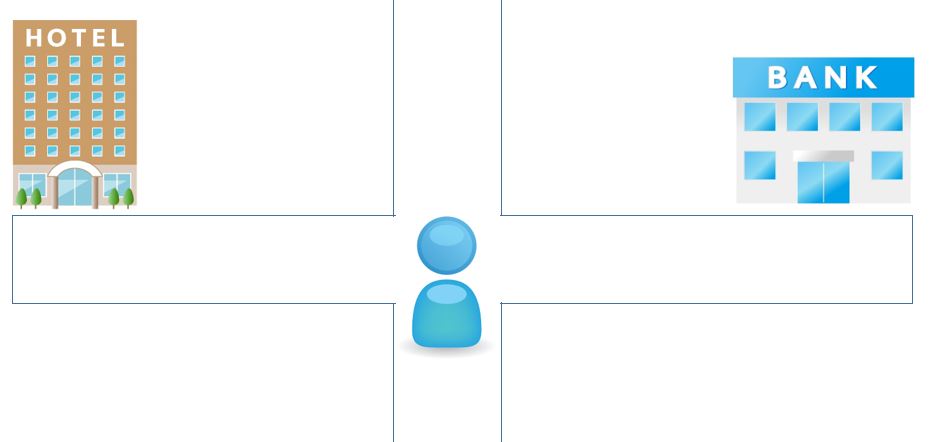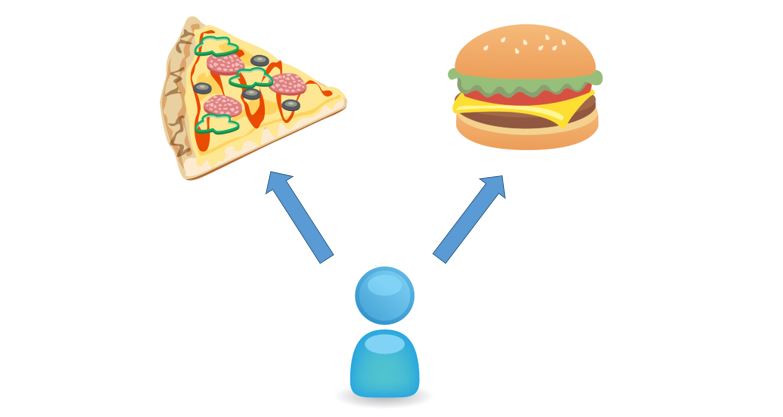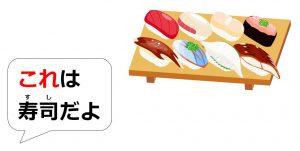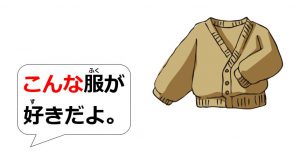Last time, you learned Japanese demonstratives: これ, それ, あれ, and どれ like “どれが寿司ですか (Which one is Sushi)? これが寿司です (This one is Sushi).” You can think of these four words as one group, where どれ is a question word, and the others are its counterparts. In this lesson, you will learn other question words with their counterparts.
Japanese Wh-questions with Japanese Demonstratives: こそあど
| Table of Contents 何 (なに・なん): What どの: Which… 誰・どなた: Who どこ: Where どっち・どちら: Which Direction |
In English, you can use “this” as both a pronoun and a determiner: “This is good,” and “This hotel is good.” In Japanese, you have to modify the form of demonstratives: “これはいい,” and “このホテルはいい.” You can consider the first hiragana as a base and change the suffixes. Each form has its related question words.
| こ– | そ– | あ– | ど– | ||
|---|---|---|---|---|---|
| Pronouns | れ-group thing |
これ this one |
それ that one |
あれ that one over there |
どれ which one |
| こ-group location |
ここ here |
そこ there |
あそこ* over there |
どこ where |
|
| っち-group ちら-group direction |
こっち こちら this way |
そっち そちら that way |
あっち あちら that way over there |
どっち どちら which way |
|
| いつ-group people |
こいつ this person |
そいつ that person |
あいつ that person over there |
どいつ which person |
|
| Determiners | の-group | この this… |
その that… |
あの that… over there |
どの which… |
| Attributes | んな-group kind |
こんな this kind of… |
そんな that kind of… |
あんな that other kind of… |
どんな what kind of… |
| Proadverbs | う-group kind |
こう like this |
そう like that |
ああ* like that over there |
どう how |
That’s simple, isn’t it? There are just two irregular pronunciations in the あ column. The concept, proper usages being determined by the distance between objects and speakers or listeners, remains the same. Here, we will focus on pronouns and determiners. You will learn proadverbs and attributes in the next lesson.
何 (What), 誰・どちら (Who), and どの (Which) with れ-group and の-group
れ-group: Pronoun (Thing)
| これは日本語の本(だ / です)。 This one is a Japanese book. |
| これは日本語の本(ですか)? Is this one a Japanese book? |
| どれが日本語の本(ですか)? Which one is a Japanese book? |
This is what you learned in the previous lesson. By replacing a demonstrative (such as これ) with its related question word (such as どれ), you can make a wh-question with the identifier particle が. Then, what should you do if you do not know what an object is and want to ask, “What is this one?” This is where you use 何.
何 (なに・なん): What
| これは | 何 | (ですか)? |
| Topic / Subject | Complement | Question Marker |
| What is this one? | ||
何 is translated as “what” in English and replaces nouns. Comparing the original example with the above one, 日本語の本 was replaced by 何. 何 can be pronounced as なに or なん. The grammatical rule is that it is always pronounced as なん if the letter after 何 is part of the Ta line (た ち つ て と), Da line (だ ぢ づ で ど), or Na line (な に ぬ ね の). Otherwise, you always pronounce 何 as なに.
| これは | 何の | 本 | (ですか)? |
| Topic / Subject | Explanation | Modified Noun | Question Marker |
| What book is this one? | |||
What if you know it is a book, but do not know what book it is? You can also ask such a specific question. Here, only 日本語 has been replaced by 何. You can figure out the meaning of a whole sentence by looking at the trailing particles. And also please pay attention to the presence of subjects. With the last two examples below, the subjects (such as “私たちは”) are omitted.
| あれは(なに / なんですか)? What is that one over there? |
| それは何の絵(ですか)? What picture is that one? |
| 何が原因(ですか)? What is the cause? |
| 何を(する / しますか)? What will [we] do? |
| 何に(乗る / 乗りますか)? What will [we] take? |
| これは | 何語の | 本 | (ですか)? |
| Topic / Subject | Explanation | Modified Noun | Question Marker |
| Lit. What language’s book is this one? | |||
If there is a noun with a suffix, you can ask a more specific question by replacing only the noun like the above example, i.e. 日本 has been replaced by 何. When used like this, 何 is always pronounced as なに except when used with 曜日 (day of the week) .
| 何駅で(降りる / 降りますか)? At which station will [we] get off? |
| 何大学に行く(の / んですか)? What university will [you] go? |
| 何味が好き(ですか)? What flavor do [you] like? |
| 今日は何曜日(ですか)? As for today, what day of the week is it? |
の-group: Determiner
| この本: this book |
| そのパソコン: that PC |
| あの人: that person over there |
The concept of Japanese determiners is the same as in English. The function is to specify generic nouns, e.g. “a book” vs. “this book.” の-group is always placed before nouns. Unlike れ-group, you can use this for people as well as things.
| (Very) Casual | Plain | Polite |
| こいつ / こっち そいつ / そっち あいつ / あっち どいつ / どっち |
この人 その人 あの人 どの人 |
この方 / こちら その方 / そちら あの方 / あちら どの方 / どちら |
There are other groups to describe people, though the two basically express directions. Please choose the group that suits your needs. Here are more examples
| (こいつ / この人 / この方 / こちら)は 先生(だ / です)よ。 This person is a teacher. |
| そのパンを(買う / 買います)よ。 [I will] buy that bread. |
| あの公園でサッカーを(する / します)よ。 [I] will play soccer at that park over there. |
どの: Which…
| どの人が | 先生 | (ですか)? |
| Topic / Subject | Complement | Question Marker |
| Which person is a teacher? | ||
どの is the question word which relates to the determiners and thus there is a sense to identify something. However, the identifier particle が appears only when question words are used as a subject. Question words, which include どの, can be used in various parts of a sentence. Again, subjects can be omitted in order to be more natural.
| どのフルーツが甘い(ですか)? Which fruit is sweet? |
| どの大学に行く(の / んですか)? To which university will [you] go? |
| どの部屋を(使う / 使いますか)? Which room will [you] use? |
| どの山で絵を(書く / 書きますか)? At which mountain will [you] draw a picture? |
誰・どなた: Who
| この人は | 誰 / どなた | (ですか)? |
| Topic / Subject | Complement | Question Marker |
| Who is this person? | ||
誰 is a neutral word while どなた is a polite word. Both of them have the same meaning and can be translated as “who” in English. They are used in place of words that indicate people. Just like with other question words, please focus on the particles’ functions to understand the meaning of the whole sentence.
| この本は | 誰の | (ですか)? |
| Topic / Subject | Possessor | Question Marker |
| As for this book, whose is [it]? | ||
| あの人は (誰 / どなた)(ですか)? Who is that person over there? |
| (誰 / どなた)がごはんを作る(の / んですか)? Who will make a meal? |
| (誰 / どなた)に手紙を書く(の / んですか)? To whom will [you] write a letter? |
| (誰 / どなた)と学校に行く(の / んですか)? With whom will [you] go to school? |
[adsense]
どこ (Where) and どっち・どちら (Which Direction) with こ-group and っち・ちら-group
こ-group: Pronoun (Location)
| ここは図書館(だ / です)よ。 Here is a library. |
| トイレはそこ(だ / です)よ。 The washroom is there. |
| ホテルはあそこ(だ / です)よ。 The hotel is over there. |
Just like れ-group which is the pronoun for things, こ-group is the one for locations. You can use these in place of words which indicate locations.
| ホテルは隣(だ / です)よ。 The hotel is the next [building]. |
| ホテルはあそこ(だ / です)よ。 The hotel is over there. |
どこ: Where
| トイレは | どこ | (ですか)? |
| Topic / Subject | Complement | Question Marker |
| Where is a washroom? | ||
どこ is the question word related to pronouns for locations, and corresponds to “where” in English. However, while “where” can only be used for actual places, どこ can be used for “points” and “parts”, too.
| 駅はどこ(ですか)? Where is the station? |
| どこが安全(ですか)? Where is safe? |
| どこを観光(する / しますか)? Where will [you] go sightseeing? |
| どこで(泳ぐ / 泳ぎますか)? Where will [you] swim? |
| 日本語はどこが難しい(ですか)? As for Japanese, what part is difficult? |
| この映画のどこが面白い(ですか)? What point in this movie is interesting? |
っち・ちら-group: Pronoun (Direction)
| 駅は(こっち / こちら)(だ / です)よ。 The station is in this direction. |
| カフェは(あっち / あちら)(だ / です)よ。 The café is in that direction over there. |
| (そっち / そちら)は病院(だ / です)よ。 The hospital is in that direction. |
っち-group is casual while ちら-group is polite, though both of them have the same meaning. These groups have two functions. The first is to indicate direction, as the above shows. The second is to express places where the speakers or listeners are when you have a conversation.
| (こっち / こちら)は | もう | 暑い(です)よ |
| Topic / Subject | Adverb | Complement |
| My place is already hot. *Said when you talk with your friend on the phone. |
||
With this function, こっち・こちら indicate the speaker’s place, そっち・そちら indicate the listener’s place and あっち・あちら indicate the third person’s place.
どっち・どちら: Which Direction
| 空港は | どっち / どちら | (ですか)? |
| Topic / Subject | Complement | Question Marker |
| In which direction is the airport? | ||
どっち and どちら are the question words related to pronouns for directions. There are two main usages. The first is to ask for directions.
| ホテルは(どっち / どちら)(ですか)? In which direction is the hotel? |
| 銀行は(どっち / どちら)(ですか)? In which direction is the bank? |
| (どっち / どちら)に(行く / 行きますか)? In which direction will [we] go? |
The second is that どっち and どちら can actually be used to express “which one” like どれ and どの.
| ピザは(どっち / どちら)(ですか)? Which one [of the two] is a pizza? |
| ハンバーガーは(どっち / どちら)(ですか)? Which one [of the two] is a hamburger? |
| (どっち / どちら)が私の(ですか)? Which one [of the two] is mine? |
| (どっち / どちら)の味が好き(ですか)? Which flavor [of the two] do [you] like? |
| (どっち / どちら)を(食べる / 食べますか)? Which one [of the two] will [you] eat? |
One important point here is that they imply there are just two options. If you have more than two options, you have to use どれ for things or どの + suffixes like どの人 for people.
Summary
- Pronouns are replaced with nouns
- Determiners are placed before nouns
- Question words can appear in any part in a sentence
- Particles are the key to figuring out meanings
- Subjects are often omitted
In this lesson, you have learned a lot of vocabulary. However, if you look at the structures, they are very similar. If you understand the above, you can easily figure out the meanings of sentences. Next, you will learn the rest of the demonstratives: attributes and proadverbs.







